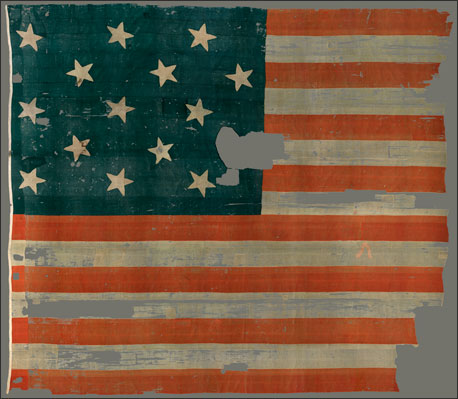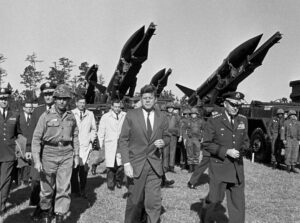Francis Scott Key was born on August 1, 1779 in Terra Rubra, Maryland. After graduating college, Key began to study law in hopes of becoming an attorney.1 Soon after, Keys got married and had eleven children and moved to Georgetown where he started his own practice.2 Key became very successful in his work as a lawyer, and for hobbies he sang for the church and wrote poems, a lot of which are still appreciated today. When the War of 1812 broke out, Key enlisted in the US army.3

Francis Scott Key was sent to a British ship to negotiate the release of certain prisoners. Upon Key’s arrival to the ship, he showed the Commodore of the ship letters from British troops that had been captured by American forces.4 The letters explained how well they were being treated and that they were not harmed in any way. After seeing this, the Commodore let their prisoner William Beanes free, but before the three American men could leave, the British troops were preparing to attack Fort McHenry, and therefore needed to keep them on the ship so that they would not be able to return back to warn the American troops.5
For over twenty-four hours the two sides, American and British, exchanged fire. The British recorded that “over eight hundred shells” were shot at the fort.6 After twenty-four hours of fighting both on land and sea, Francis Scott Key waited for the smoke to clear and saw that the American flag at Fort McHenry was still waving high. Key immediately began to write a poem on what he had witnessed that day. The poem quickly rose to fame and gained the attention of almost every single American.7
Very few people know that the poem went through different phases before becoming the American National Anthem. The original title of the poem was “The Defense of Fort McHenry.” Key later added the tune from an old drinking song called “To Anacreon in Heaven.”8 Later, Congress met to decide on a song for the nation; all songs were rejected, including “The Defense on Fort McHenry.” People that opposed the song claimed that the lyrics were too difficult to sing, it was not martial enough, and it was only about one event in all of American history.9 People who supported the song loved that the lyrics were difficult; that way only professional musicians and singers could sing it before certain important occasions.10
It was not until 1916 that the United States made the “The Star-Spangled Banner” the unofficial nation anthem. Woodrow Wilson was asked to have a “ceremonial song” for the United States, so he picked the most loved song by the people of the United States.11 But it was not until 1931 that Congress adopted the “The Star-Spangled Banner” as the official nation anthem of America. The poem was seen and adored by Americans for the patriotism it stood for and as a reminder of its past victories. This song is now sung before almost every major event in the United States to serve as a reminder of America’s victory against all odds.12
While the first stanza of the poem is widely known and sung today, few have been able to appreciate it in its entirety. Here, then, is the original poem:
O say can you see, by the dawn’s early light,
What so proudly we hail’d at the twilight’s last gleaming,
Whose broad stripes and bright stars through the perilous fight
O’er the ramparts we watch’d were so gallantly streaming?
And the rocket’s red glare, the bomb bursting in air,
Gave proof through the night that our flag was still there,
O say does that star-spangled banner yet wave
O’er the land of the free and the home of the brave?
On the shore dimly seen through the mists of the deep
Where the foe’s haughty host in dread silence reposes,
What is that which the breeze, o’er the towering steep,
As it fitfully blows, half conceals, half discloses?
Now it catches the gleam of the morning’s first beam,
In full glory reflected now shines in the stream,
‘Tis the star-spangled banner – O long may it wave
O’er the land of the free and the home of the brave!
And where is that band who so vauntingly swore,
That the havoc of war and the battle’s confusion
A home and a Country should leave us no more?
Their blood has wash’d out their foul footstep’s pollution.
No refuge could save the hireling and slave
From the terror of flight or the gloom of the grave,
And the star-spangled banner in triumph doth wave
O’er the land of the free and the home of the brave.
O thus be it ever when freemen shall stand
Between their lov’d home and the war’s desolation!
Blest with vict’ry and peace may the heav’n rescued land
Praise the power that hath made and preserv’d us a nation!
Then conquer we must, when our cause it is just,
And this be our motto – “In God is our trust,”
And the star-spangled banner in triumph shall wave
O’er the land of the free and the home of the brave.13
- War of 1812, 2002, s.v. “Key, Francis Scott.” ↵
- War of 1812, 2002, s.v. “Key, Francis Scott.” ↵
- War of 1812, 2002, s.v. “Key, Francis Scott.” ↵
- War of 1812, 2002, s.v. “Key, Francis Scott.” ↵
- UXL Encyclopedia of U.S. History, 2009, s.v. “The Star-Spangled Banner,” by Sonia Benson, Daniel E. Brannen, Jr., and Rebecca Valentine. ↵
- UXL Encyclopedia of U.S. History, 2009, s.v. “The Star-Spangled Banner,” by Sonia Benson, Daniel E. Brannen, Jr., and Rebecca Valentine. ↵
- UXL Encyclopedia of U.S. History, 2009, s.v. “The Star-Spangled Banner,” by Sonia Benson, Daniel E. Brannen, Jr., and Rebecca Valentine. ↵
- “Key, Francis Scott,” in Shaping of America, 1783-1815 Reference Library, edited by Lawrence W. Baker, Richard C. Hanes, Sharon M. Hanes, and Kelly Rudd, Vol. 2, Biographies Volume 1, 257. ↵
- “Key, Francis Scott,” in Shaping of America, 1783-1815 Reference Library, edited by Lawrence W. Baker, Richard C. Hanes, Sharon M. Hanes, and Kelly Rudd, Vol. 2, Biographies Volume 1, 258. ↵
- “Key, Francis Scott.” In Shaping of America, 1783-1815 Reference Library, edited by Lawrence W. Baker, Richard C. Hanes, Sharon M. Hanes, and Kelly Rudd, . Vol. 2, Biographies Volume 1,258. ↵
- “Key, Francis Scott.” In Shaping of America, 1783-1815 Reference Library, edited by Lawrence W. Baker, Richard C. Hanes, Sharon M. Hanes, and Kelly Rudd, Vol. 2, Biographies Volume 1,258. ↵
- UXL Encyclopedia of U.S. History, 2009 s.v. “The Star-Spangled Banner,” by Benson, Sonia, Daniel E. Brannen, Jr., and Rebecca Valentine. ↵
- Francis Scott Key, “The Star-Spangled Banner” (wording of the original handwritten manuscript, in the Museum Department of the Maryland Historical Society). ↵



101 comments
Nathan Castillo
I really never knew the origin of the Star Spangled Banner or how it was finally adopted. I was surprised that the anthem was finally adopted in 1931 which is really late in time. I always thought that it was adopted immediately after it was written because it seemed so inspiring. It is so weird to see how long it took for it to finally be normalized and then for it to become America’s anthem.
Lindsey Ogle
I never knew so much about the star spangled banner like the history of the song or its origin. I also did not know about the title change and the multiple rejections. And there are many more verses that most people do not know about.
Amanda Gutierrez
Interesting article! It was enlightening to read about the process of how the song became our National Anthem. I enjoyed learning about the history of the song and how important the song truly is. Good job!
Savannah Palmer
As someone who has an interest in music, I am constantly intrigued by the history behind the works of writers and composers. Prior to this article, I was only vaguely aware of the history behind the Star Spangled Banner. I knew that it was written by Francis Scott Key, but I never recognized how the importance of the poem has transpired through centuries. Reading about how Wilson used this song to honor America’s ability to overcome has helped me to recognize how important Americans value honoring historical triumphs. By having the Star Spangled Banner performed at almost all events, it enables Americans to be reminded of the importance of historical battles, such as the battle at Fort McHenry. This iconic tribute to the United States has brought to life the Patriotism of a nation full of history.
Kennedy Arcos
This was such an interesting article. I have obviously always known The Star Spangled Banner just about all my life, but I have never really known how it came about. I had no idea that this anthem came from a poem. I find it interesting how the National Anthem went through so many changes and phases before reaching to what it is today. It was really cool learning about the origin of this, great article!
Jose Chaman
This article is quite informative, entertaining and accurate. Being an international student, I had never noticed the anthem of the United States, that is why this article called my attention. It is incredible to know that the anthem was created based on this wonderful poem written by Francis Scott Key. The most amazing thing is the way in which this poem was inspired: after a battle for the negotiation of the release of certain American prisoners.
Saira Locke
In today’s world we sing the Star-spangled Banner in a ton of major events to represent our country and to express who we are. It was very cool to see the process of Francis Keys song, there were so many phases and cuts in the song. The song has deep meaning for our country that is truly special and shows the respect for the people that have served to protect our beautiful country.
Ashley Martinez
I really enjoyed reading about this article, it was great to learn about the history of the Star Spangled Banner. The Star Spangled Banner went through numerous changes pertaining to its name and several rejections. I had no idea that Francis Scott Key was the author of what was originally a poem that now represents our country with great honor and respect. The Star Spangled Banner originally was a simple poem but now it is used for greater purposes to show respect for our country and those who have served to protect it and continue to do so.
Eloy Cruz
I never knew that there was more verses to the Star-Spangled Banner, let alone multiple rejections and title changes. I think that Francis Scott Key did a great job to represent the patriotism of this country. I really liked learning about the history of the song and about the multiple opinions that were made of the song during its time and after the poem was written.
Michael Lazcano
Today the Star Spangled Banner is sung before every big national game playing on television, some people sing along, bow their heads in silence, or even kneel now, but they all recognize it as the national anthem. Scott Key didn’t originally intend for the poem to actually be a huge part of the American society, it simply was to be an account for what was happening in the war. While the songs meaning has changed over the years, due to different issues dividing or uniting the American people it has stuck with us. The battle of For McHenry may have been hundred of years ago, but we still fight battles domestic and international, which is why the Star Spangled Banner is important today.